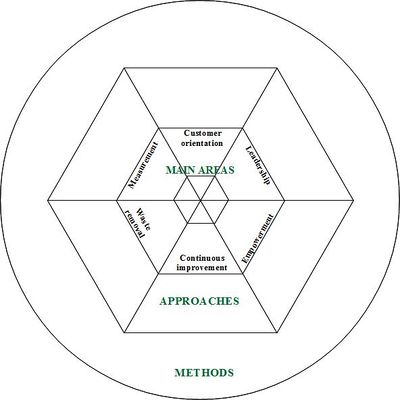Silvestro model
| Silvestro model |
|---|
| See also |
Silvestro model was introduced by R. Silvestro in 1998 as model of Quality management system adapted to the service organizations. It consists of three parts: the inner contains the key areas, the middle expands them and shows a methods supporting the external action of TQM in the field of services.
Main areas of Silvestro model
- customer orientation,
- leadership,
- empowerment,
- continuous improvement,
- elimination of waste,
- measurement of quality.
Pro-customer orientation in services is the result of efficient management and the interaction between the supplier and the customer. Achievement of the proper attitude to the customer requires identification of internal and external customers and identification of their needs. Relationships with suppliers must take into account their awareness of the external client requirements, and should ensure proper operation of the quality chain.
Approaches
- Leadership in service organizations requires, as in the production companies, orientation of strategy to client needs, flatten organizational structure, facilitation and motivation to work.
- Empowerment is necessary in relation to employees having direct contact with the client to allow to settle all the matters with a small number of people. However, in relation to other employees there should be adopted such a level of empowerment that is needed for the provision of assistance to the front office.
- According to R. Silvestro continuous improvement in services should be apply as a process.
- Elimination of waste in an involves the introduction of methods for performing the tasks right from the first time, but at the same time encouraging customers to inform employees about all noticed imperfections.
- Due to the difficulty in obtaining quantitative data, there is a limited use of statistical methods of quality measurement in services. Those methods can be used mainly in the so-called back-office and in the case of bulk services.
Methods
Proposed by R. Silvestro model is focused on methods and ways to implement the key areas of service organizations, which can be used to build the QMS model for the offices of the local government.
References
- Brignall, S., Silvestro, R., & Fitzgerald, L. (1991). Performance measurement in service businesses. London: Chartered Institute of Management Accountants.
- Silvestro R., (1998) The manufacturing TQM and service quality literatures: synergistic or conflicting paradigms?, International Journal of Quality & Reliability Management, no 3, Emerald Group Publishing, Bradford.
- Silvestro, R., Fitzgerald, L., Johnston, R., & Voss, C. (1992). Towards a classification of service processes. International journal of service industry management, 3(3), 62-75.
Author: Slawomir Wawak
